外研版 英语 七年级下册 Module 6Around town Unit 3 习题课件(共35张PPT)
文档属性
| 名称 | 外研版 英语 七年级下册 Module 6Around town Unit 3 习题课件(共35张PPT) | 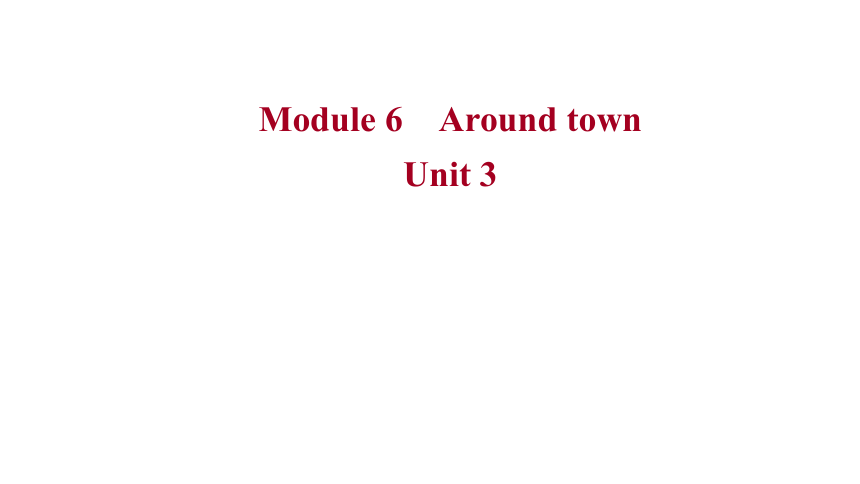 | |
| 格式 | ppt | ||
| 文件大小 | 446.5KB | ||
| 资源类型 | 教案 | ||
| 版本资源 | 外研版 | ||
| 科目 | 英语 | ||
| 更新时间 | 2022-06-09 14:54:47 | ||
图片预览

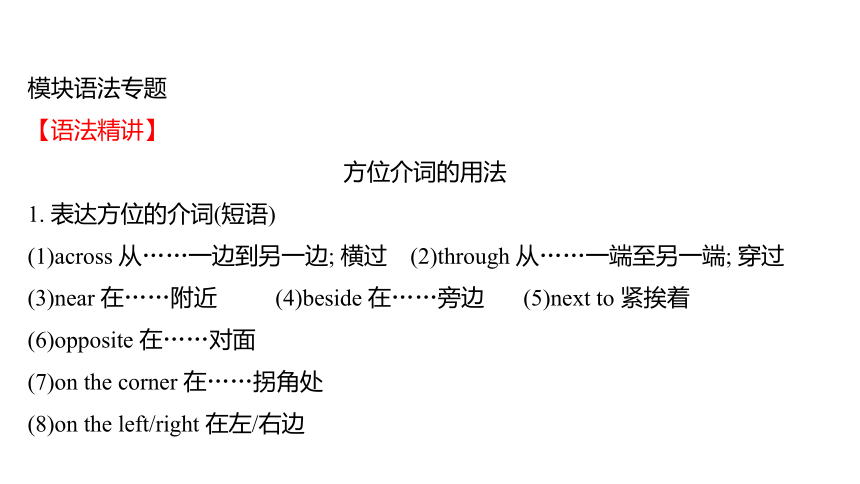
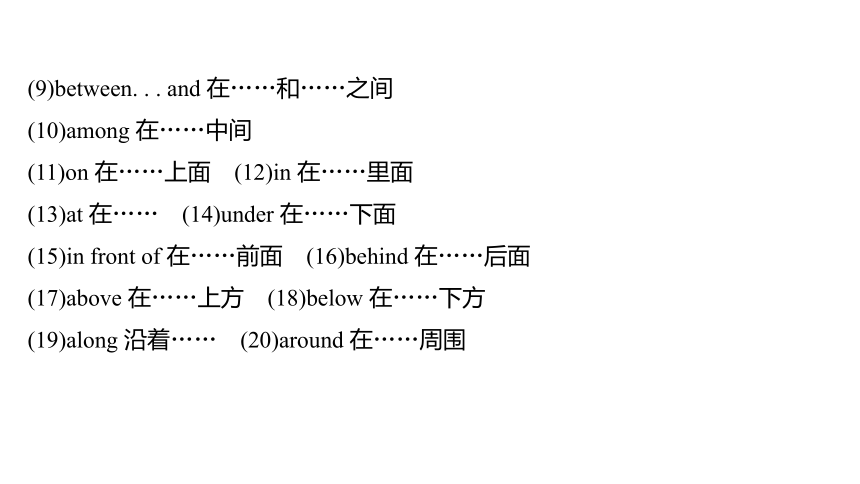
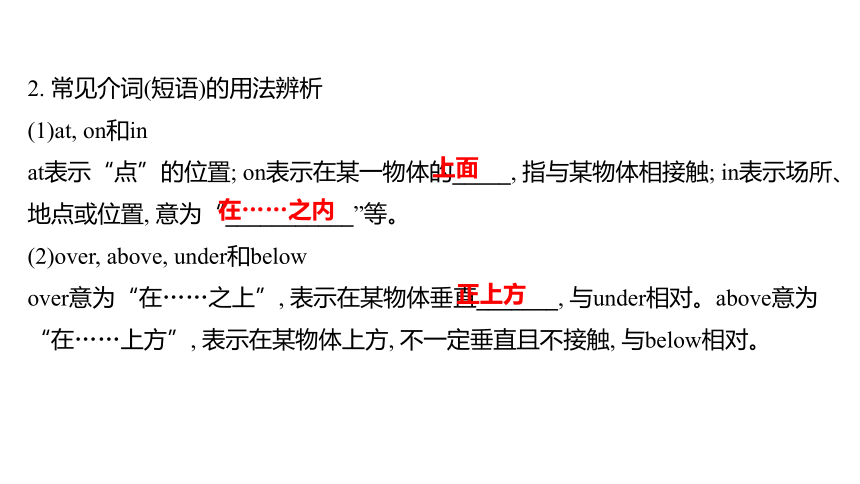
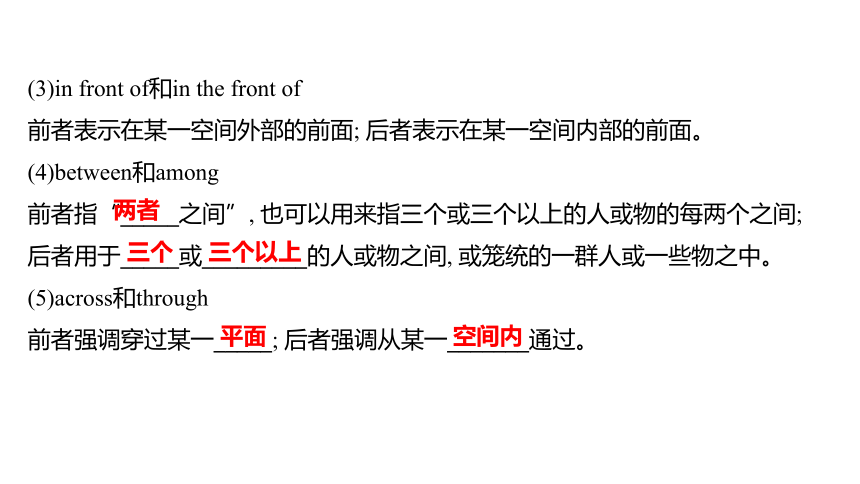
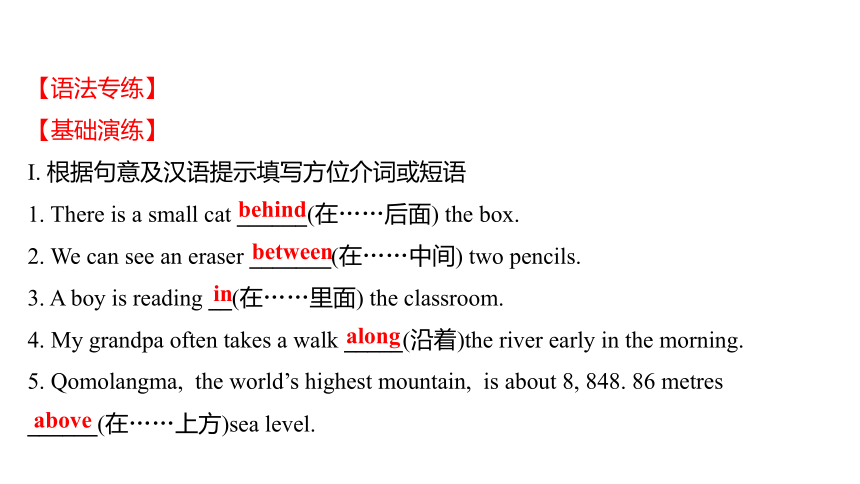
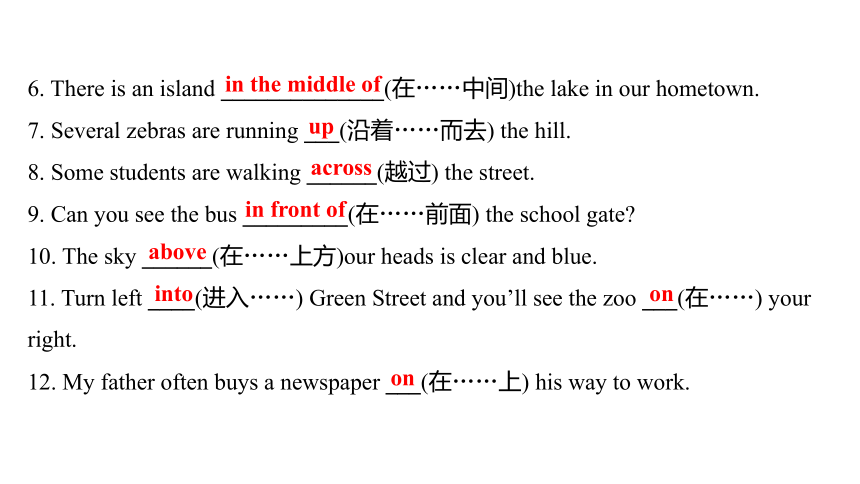

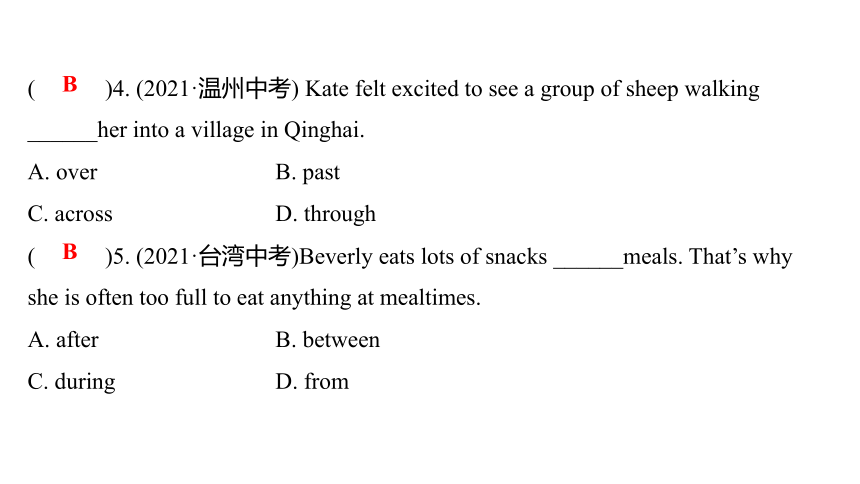
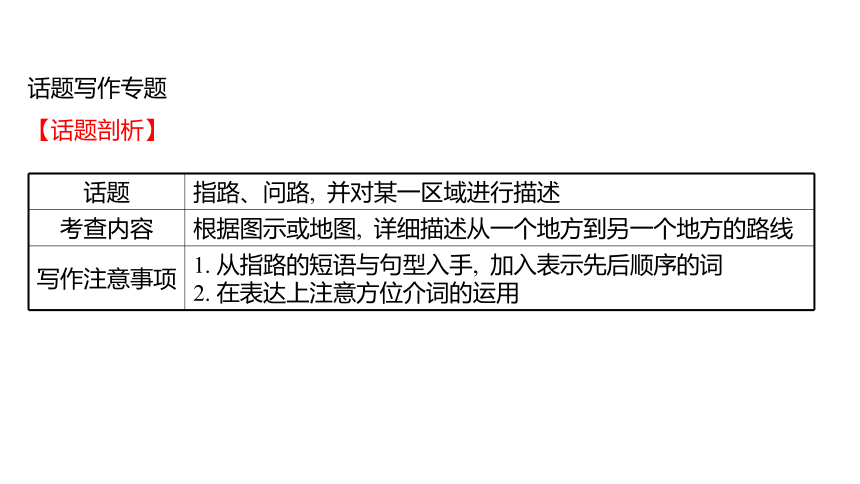
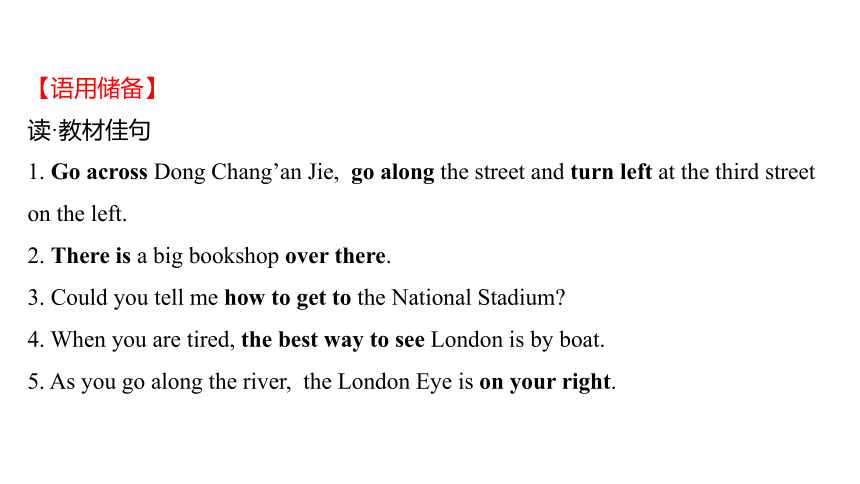
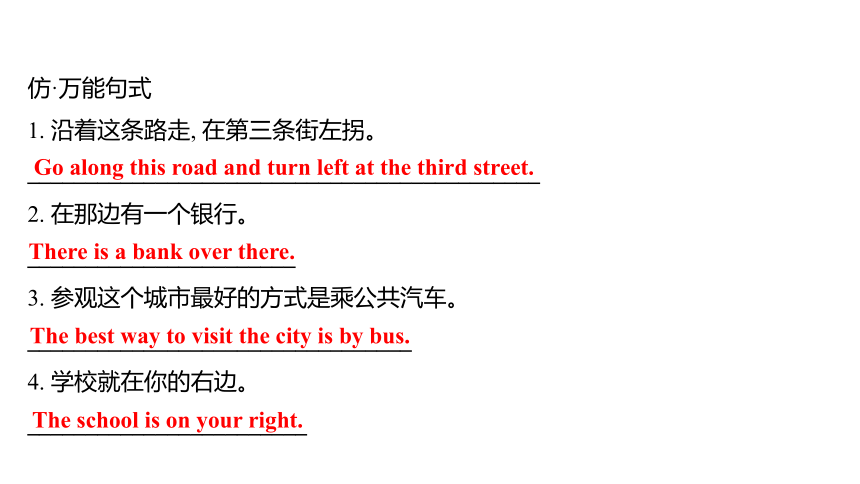
文档简介
(共35张PPT)
Module 6 Around town
Unit 3
模块语法专题
【语法精讲】
方位介词的用法
1. 表达方位的介词(短语)
(1)across 从……一边到另一边; 横过 (2)through 从……一端至另一端; 穿过 (3)near 在……附近 (4)beside 在……旁边 (5)next to 紧挨着
(6)opposite 在……对面
(7)on the corner 在……拐角处
(8)on the left/right 在左/右边
(9)between. . . and 在……和……之间
(10)among 在……中间
(11)on 在……上面 (12)in 在……里面
(13)at 在…… (14)under 在……下面
(15)in front of 在……前面 (16)behind 在……后面
(17)above 在……上方 (18)below 在……下方
(19)along 沿着…… (20)around 在……周围
2. 常见介词(短语)的用法辨析
(1)at, on和in
at表示“点”的位置; on表示在某一物体的_____, 指与某物体相接触; in表示场所、
地点或位置, 意为“___________”等。
(2)over, above, under和below
over意为“在……之上”, 表示在某物体垂直_______, 与under相对。above意为
“在……上方”, 表示在某物体上方, 不一定垂直且不接触, 与below相对。
上面
在……之内
正上方
(3)in front of和in the front of
前者表示在某一空间外部的前面; 后者表示在某一空间内部的前面。
(4)between和among
前者指“_____之间”, 也可以用来指三个或三个以上的人或物的每两个之间;
后者用于_____或_________的人或物之间, 或笼统的一群人或一些物之中。
(5)across和through
前者强调穿过某一_____; 后者强调从某一_______通过。
两者
三个
三个以上
平面
空间内
【语法专练】
【基础演练】
Ⅰ. 根据句意及汉语提示填写方位介词或短语
1. There is a small cat ______(在……后面) the box.
2. We can see an eraser _______(在……中间) two pencils.
3. A boy is reading __(在……里面) the classroom.
4. My grandpa often takes a walk _____(沿着)the river early in the morning.
5. Qomolangma, the world’s highest mountain, is about 8, 848. 86 metres ______(在……上方)sea level.
behind
between
in
along
above
6. There is an island ______________(在……中间)the lake in our hometown.
7. Several zebras are running ___(沿着……而去) the hill.
8. Some students are walking ______(越过) the street.
9. Can you see the bus _________(在……前面) the school gate
10. The sky ______(在……上方)our heads is clear and blue.
11. Turn left ____(进入……) Green Street and you’ll see the zoo ___(在……) your
right.
12. My father often buys a newspaper ___(在……上) his way to work.
in the middle of
up
across
in front of
above
into
on
on
【中考挑战】
Ⅱ. 单项选择
( )1. (2021·天津中考) Anna is taller than me. She sits ______me in the
classroom.
A. between B. from C. behind D. among
( )2. (2021·梧州中考) I often go to school ______foot.
A. in B. by C. on D. at
( )3. (2021·青海中考改编)Look! The sun is shining directly into the car.
You’d better park it______ the tree.
A. under B. in front of C. behind D. above
C
C
A
( )4. (2021·温州中考) Kate felt excited to see a group of sheep walking
______her into a village in Qinghai.
A. over B. past
C. across D. through
( )5. (2021·台湾中考)Beverly eats lots of snacks ______meals. That’s why
she is often too full to eat anything at mealtimes.
A. after B. between
C. during D. from
B
B
话题写作专题
【话题剖析】
话题 指路、问路, 并对某一区域进行描述
考查内容 根据图示或地图, 详细描述从一个地方到另一个地方的路线
写作注意事项 1. 从指路的短语与句型入手, 加入表示先后顺序的词
2. 在表达上注意方位介词的运用
【语用储备】
读·教材佳句
1. Go across Dong Chang’an Jie, go along the street and turn left at the third street on the left.
2. There is a big bookshop over there.
3. Could you tell me how to get to the National Stadium
4. When you are tired, the best way to see London is by boat.
5. As you go along the river, the London Eye is on your right.
仿·万能句式
1. 沿着这条路走, 在第三条街左拐。
____________________________________________
2. 在那边有一个银行。
_______________________
3. 参观这个城市最好的方式是乘公共汽车。
_________________________________
4. 学校就在你的右边。
________________________
Go along this road and turn left at the third street.
There is a bank over there.
The best way to visit the city is by bus.
The school is on your right.
【类题仿写】
假如你是李明, 你收到了美国朋友Robin的来信, 他在信中说他将和他妹妹到北京来看望你, 对此你表示高兴和欢迎。但你碰巧要去珠海出席一个会议, 无法接他们。为此, 你向Robin深表歉意并在信中告诉他从机场到你家如何走, 说明你家在403室, 你母亲到时会在家中迎候他们, 最后告诉他们你将于两天后回北京。
要求:
1. 短文必须包括文字说明的所有重点;
2. 短文必须按图中所示的交通路线和交通方式组织语言。
【考场·答题流程】
Step 1: “五定”审题
定体裁 ①_______ 定人称 ②_________
定时态 ③___________
定要点
定结构 ④解释原因
⑤详细指路
⑥提出希望
说明文
第二人称
一般现在时
Step 2: “三段”谋篇
第一段: 解析原因
1. 因为我在珠海有个会议, 我就不能去接你们了。(have a meeting)
_______________________________________________
第二段: 详细指路。
2. 出机场后, 你们可以乘坐359路公交车到东直门汽车站。(take)
________________________________________________________________
_______
I can’t meet you because I’ll have a meeting in Zhuhai.
When you get out of the airport, you can take Bus 359 to Dongzhimen Bus
Station.
3. 穿过立交桥往西走, 直到你们看到右边有一家书店。(walk across)
________________________________________________________________
4. 在那里左转, 然后一直往前走。(turn left)
_________________________________
5. 然后你们可以看到一家银行, 然后在你的左边是一家电影院。(on your left)
_________________________________________________
6. 我住的公寓楼紧挨着电影院。(next to)
______________________________________________
Walk across the flyover to the west until you see a bookshop on your right.
Turn left there and go straight ahead.
Then you can see a bank, and then a cinema on your left.
The apartment building I live in is next to the cinema.
第三段: 提出希望。
7. 我希望你们在这里过得愉快。(hope)
_________________________________
Step 3: 完美成篇
____________________________________________________________________
____________________________________________________________________
____________________________________________________________________
I hope you will have a good time here.
【参考范文】
Dear Robin,
I’m very glad to learn from your letter that you and your sister will come to Beijing and visit me. But I’m very sorry that I can’t meet you because I’ll have a meeting in Zhuhai. Now let me tell you the way to my home.
When you get out of the airport, you can take Bus 359 to Dongzhimen Bus Station. Walk across the flyover to the west until you see a bookshop on your right. Turn left there and go straight ahead. Then you can see a bank, and then a cinema on your left. The apartment building I live in is next to the cinema. Find Room 403 and my mother will meet you at home.
I hope you will have a good time here. I’ll be back in two days. Best regards to you all.
Yours truly,
Li Ming
易错易混练
易错点1: 辨析cross, across与through 的用法
( )①Don’t ______the road when the traffic lights turn red.
A. across B. cross C. through D. over
( )②I have to go into the bedroom ______the window because I forget my
keys.
A. across B. cross C. through D. over
( )③Go ______the bridge, turn left at the second crossing and you will find
the bus station.
A. across B. cross C. through D. over
B
C
A
【易错归纳】
1. across和through都作介词, 意为“穿过”。但across表示从表面穿过, through表示从内部穿过。
2. cross作动词, 意为“穿过”。
易错点2: pass与past的用法
①我通常七点二十去上学。
I usually go to school at twenty ____seven.
②每次走过那间房子, 我总是停下脚步。
I always stop my step every time I _____ ____ the room.
③你在去火车站的路上会经过一家银行。
You’ll ____a bank on the way to the train station.
past
walk
past
pass
【易错归纳】
1. past作介词, 意为“路过(某地或某物)”; 常与动词go, walk, run等连用。
2. pass作动词, 意为“经过; 路过”。past作介词, 还可以意为“晚于, 在……之后, 多于”。
易错点3: Why not. . . 的用法
①Why don’t we go to the zoo this afternoon (改为同义句)
_____ ___ ___ to the zoo this afternoon
②你为什么不独立做作业呢
_____ ___ ___ homework by yourself
【易错归纳】
Why not. . . 后接动词原形, 意为“为什么不……”, 用于提建议。
Why
not
go
Why
not
do
易错点4: finish的用法
①请认真做完你的作业。
Please _____ _____ your homework carefully.
②Finish ______(sell)the apples and then go home.
【易错归纳】
finish后接名词、代词或动词-ing形式作宾语。
finish
doing
selling
综合能力练
Ⅰ. 选词填空
根据短文内容, 从方框中选择恰当的单词填空。每个单词只能用一次, 每空一词。
station questions friend’s way thanks take Excuse enjoying gives with
Tina is visiting her friend Linda in London. Today, Linda goes to work and
she 1. _____Tina a map of the city. Tina wants to 2. ____a walk in Hyde Park. So
she walks out of the apartment (公寓). And then she sees a woman 3. ____two
children. Tina thinks, “The map can help me find my 4. ____, but I don’t know
where this apartment building is on the map. ” So she asks the woman, “5. _______
me, is Hyde Park near here ”
gives
take
with
way
Excuse
The woman smiles (微笑) and says, “Yes, you need to walk to the bus 6.
______and turn left. ”
“Thank you. But can you show (显示) me where we are on the map ”
The woman shows Tina where her 7. _______apartment building is on the map.
Tina 8. ______her again.
“Have a nice day! ” Tina says to herself when she walks away. She looks forward
to 9. ________herself in the park. She is happy because she is able to ask
10. _________in English now. She soon finds the park and has great fun in it.
station
friend’s
thanks
enjoying
questions
Ⅱ. 阅读理解
A
I travel to a city that I don’t know at all.
One day I go around by myself. It’s a good way to know about the city. After walking for two hours I want to go back to my hotel for lunch. But I don’t know the way back to the hotel after walking for some time. I think I have to ask the way. But the only word I know is the name of the street where I live, and I pronounce (发音) badly. I stop to ask a newspaper seller (卖报纸的人). He hands me a newspaper. I say no and tell him the name of the street again and again, but he just puts the newspaper in my hands. I give him $2 and go on walking.
Then I ask a policeman. He points (指) left and right and left again. I listen to him carefully and then start walking in the direction (方向) he tells me. About an hour later, I see that the buildings are getting fewer and fewer. And there are many fields . I come all the way to the countryside! The only thing for me to do is find the nearest (最近的) train station. That is really a bad day!
( )1. After walking in the city for some time, the writer ______.
A. learns a lot about the city B. finds many interesting places
C. feels very tired D. can’t find his way back to the hotel
( )2. We can learn from the last paragraph that ______.
A. the policeman doesn’t know where the writer really wants to go
B. the policeman tells the writer where to take the train
C. the writer is happy to come to the countryside
D. the writer finds his hotel at last
D
A
( )3. The underlined word“fields” in Paragraph 3 means ______in Chinese.
A. 田地 B. 高楼 C. 山脉 D. 鲜花
( )4. What’s the writer’s real problem (问题) according to the passage
A. He doesn’t know the city at all.
B. He can’t speak the language (语言) of the city.
C. He has a poor sense of direction (方向感不好).
D. He isn’t good at talking with others.
( )5. What’s the best title for the passage
A. How to Ask the Way B. An Interesting Story
C. How to Learn a Language D. A Really Bad Day
A
B
D
B
London is one of the most famous cities in the world. It’s a large city. It has a population of about 9, 000, 000. From about the year 1800 until World War Ⅱ(1939-1945), London was the biggest city in the world. But now there are many cities which are much bigger than it.
London is famous for many things. Tourists come from all over the world go to visit its famous buildings, for example, Big Ben.
Like many other big cities, London has problems of traffic and pollution(污染) which stop the city from developing. Over one million people use the London underground every day, but there are still too many cars on the streets. The air isn’t clear, but it is much cleaner than it was 100 years ago.
For me, the best things about London are the parks. There are five in the city center. But my children’s favourite place is Hamleys, a famous toy shop in the world.
( )6. London was the biggest city in the world in ______.
A. 1795 B. 1940 C. 1987 D. 1999
( )7. Big Ben is ______in London.
A. a park B. a library
C. a river D. a building
( )8. What’s the meaning of the underlined word “developing” in Chinese
A. 降落 B. 起飞 C. 发展 D. 产生
B
D
C
( )9. Hamleys is ____according to the passage.
A. a park B. a toy shop
C. a museum D. an old city
( )10. Which of the following is TRUE according to the passage
A. London has a population of about 80, 908, 000.
B. London has problems of weather and pollution.
C. The writer thinks the best things about London are parks.
D. There are eight parks in London.
B
C
Module 6 Around town
Unit 3
模块语法专题
【语法精讲】
方位介词的用法
1. 表达方位的介词(短语)
(1)across 从……一边到另一边; 横过 (2)through 从……一端至另一端; 穿过 (3)near 在……附近 (4)beside 在……旁边 (5)next to 紧挨着
(6)opposite 在……对面
(7)on the corner 在……拐角处
(8)on the left/right 在左/右边
(9)between. . . and 在……和……之间
(10)among 在……中间
(11)on 在……上面 (12)in 在……里面
(13)at 在…… (14)under 在……下面
(15)in front of 在……前面 (16)behind 在……后面
(17)above 在……上方 (18)below 在……下方
(19)along 沿着…… (20)around 在……周围
2. 常见介词(短语)的用法辨析
(1)at, on和in
at表示“点”的位置; on表示在某一物体的_____, 指与某物体相接触; in表示场所、
地点或位置, 意为“___________”等。
(2)over, above, under和below
over意为“在……之上”, 表示在某物体垂直_______, 与under相对。above意为
“在……上方”, 表示在某物体上方, 不一定垂直且不接触, 与below相对。
上面
在……之内
正上方
(3)in front of和in the front of
前者表示在某一空间外部的前面; 后者表示在某一空间内部的前面。
(4)between和among
前者指“_____之间”, 也可以用来指三个或三个以上的人或物的每两个之间;
后者用于_____或_________的人或物之间, 或笼统的一群人或一些物之中。
(5)across和through
前者强调穿过某一_____; 后者强调从某一_______通过。
两者
三个
三个以上
平面
空间内
【语法专练】
【基础演练】
Ⅰ. 根据句意及汉语提示填写方位介词或短语
1. There is a small cat ______(在……后面) the box.
2. We can see an eraser _______(在……中间) two pencils.
3. A boy is reading __(在……里面) the classroom.
4. My grandpa often takes a walk _____(沿着)the river early in the morning.
5. Qomolangma, the world’s highest mountain, is about 8, 848. 86 metres ______(在……上方)sea level.
behind
between
in
along
above
6. There is an island ______________(在……中间)the lake in our hometown.
7. Several zebras are running ___(沿着……而去) the hill.
8. Some students are walking ______(越过) the street.
9. Can you see the bus _________(在……前面) the school gate
10. The sky ______(在……上方)our heads is clear and blue.
11. Turn left ____(进入……) Green Street and you’ll see the zoo ___(在……) your
right.
12. My father often buys a newspaper ___(在……上) his way to work.
in the middle of
up
across
in front of
above
into
on
on
【中考挑战】
Ⅱ. 单项选择
( )1. (2021·天津中考) Anna is taller than me. She sits ______me in the
classroom.
A. between B. from C. behind D. among
( )2. (2021·梧州中考) I often go to school ______foot.
A. in B. by C. on D. at
( )3. (2021·青海中考改编)Look! The sun is shining directly into the car.
You’d better park it______ the tree.
A. under B. in front of C. behind D. above
C
C
A
( )4. (2021·温州中考) Kate felt excited to see a group of sheep walking
______her into a village in Qinghai.
A. over B. past
C. across D. through
( )5. (2021·台湾中考)Beverly eats lots of snacks ______meals. That’s why
she is often too full to eat anything at mealtimes.
A. after B. between
C. during D. from
B
B
话题写作专题
【话题剖析】
话题 指路、问路, 并对某一区域进行描述
考查内容 根据图示或地图, 详细描述从一个地方到另一个地方的路线
写作注意事项 1. 从指路的短语与句型入手, 加入表示先后顺序的词
2. 在表达上注意方位介词的运用
【语用储备】
读·教材佳句
1. Go across Dong Chang’an Jie, go along the street and turn left at the third street on the left.
2. There is a big bookshop over there.
3. Could you tell me how to get to the National Stadium
4. When you are tired, the best way to see London is by boat.
5. As you go along the river, the London Eye is on your right.
仿·万能句式
1. 沿着这条路走, 在第三条街左拐。
____________________________________________
2. 在那边有一个银行。
_______________________
3. 参观这个城市最好的方式是乘公共汽车。
_________________________________
4. 学校就在你的右边。
________________________
Go along this road and turn left at the third street.
There is a bank over there.
The best way to visit the city is by bus.
The school is on your right.
【类题仿写】
假如你是李明, 你收到了美国朋友Robin的来信, 他在信中说他将和他妹妹到北京来看望你, 对此你表示高兴和欢迎。但你碰巧要去珠海出席一个会议, 无法接他们。为此, 你向Robin深表歉意并在信中告诉他从机场到你家如何走, 说明你家在403室, 你母亲到时会在家中迎候他们, 最后告诉他们你将于两天后回北京。
要求:
1. 短文必须包括文字说明的所有重点;
2. 短文必须按图中所示的交通路线和交通方式组织语言。
【考场·答题流程】
Step 1: “五定”审题
定体裁 ①_______ 定人称 ②_________
定时态 ③___________
定要点
定结构 ④解释原因
⑤详细指路
⑥提出希望
说明文
第二人称
一般现在时
Step 2: “三段”谋篇
第一段: 解析原因
1. 因为我在珠海有个会议, 我就不能去接你们了。(have a meeting)
_______________________________________________
第二段: 详细指路。
2. 出机场后, 你们可以乘坐359路公交车到东直门汽车站。(take)
________________________________________________________________
_______
I can’t meet you because I’ll have a meeting in Zhuhai.
When you get out of the airport, you can take Bus 359 to Dongzhimen Bus
Station.
3. 穿过立交桥往西走, 直到你们看到右边有一家书店。(walk across)
________________________________________________________________
4. 在那里左转, 然后一直往前走。(turn left)
_________________________________
5. 然后你们可以看到一家银行, 然后在你的左边是一家电影院。(on your left)
_________________________________________________
6. 我住的公寓楼紧挨着电影院。(next to)
______________________________________________
Walk across the flyover to the west until you see a bookshop on your right.
Turn left there and go straight ahead.
Then you can see a bank, and then a cinema on your left.
The apartment building I live in is next to the cinema.
第三段: 提出希望。
7. 我希望你们在这里过得愉快。(hope)
_________________________________
Step 3: 完美成篇
____________________________________________________________________
____________________________________________________________________
____________________________________________________________________
I hope you will have a good time here.
【参考范文】
Dear Robin,
I’m very glad to learn from your letter that you and your sister will come to Beijing and visit me. But I’m very sorry that I can’t meet you because I’ll have a meeting in Zhuhai. Now let me tell you the way to my home.
When you get out of the airport, you can take Bus 359 to Dongzhimen Bus Station. Walk across the flyover to the west until you see a bookshop on your right. Turn left there and go straight ahead. Then you can see a bank, and then a cinema on your left. The apartment building I live in is next to the cinema. Find Room 403 and my mother will meet you at home.
I hope you will have a good time here. I’ll be back in two days. Best regards to you all.
Yours truly,
Li Ming
易错易混练
易错点1: 辨析cross, across与through 的用法
( )①Don’t ______the road when the traffic lights turn red.
A. across B. cross C. through D. over
( )②I have to go into the bedroom ______the window because I forget my
keys.
A. across B. cross C. through D. over
( )③Go ______the bridge, turn left at the second crossing and you will find
the bus station.
A. across B. cross C. through D. over
B
C
A
【易错归纳】
1. across和through都作介词, 意为“穿过”。但across表示从表面穿过, through表示从内部穿过。
2. cross作动词, 意为“穿过”。
易错点2: pass与past的用法
①我通常七点二十去上学。
I usually go to school at twenty ____seven.
②每次走过那间房子, 我总是停下脚步。
I always stop my step every time I _____ ____ the room.
③你在去火车站的路上会经过一家银行。
You’ll ____a bank on the way to the train station.
past
walk
past
pass
【易错归纳】
1. past作介词, 意为“路过(某地或某物)”; 常与动词go, walk, run等连用。
2. pass作动词, 意为“经过; 路过”。past作介词, 还可以意为“晚于, 在……之后, 多于”。
易错点3: Why not. . . 的用法
①Why don’t we go to the zoo this afternoon (改为同义句)
_____ ___ ___ to the zoo this afternoon
②你为什么不独立做作业呢
_____ ___ ___ homework by yourself
【易错归纳】
Why not. . . 后接动词原形, 意为“为什么不……”, 用于提建议。
Why
not
go
Why
not
do
易错点4: finish的用法
①请认真做完你的作业。
Please _____ _____ your homework carefully.
②Finish ______(sell)the apples and then go home.
【易错归纳】
finish后接名词、代词或动词-ing形式作宾语。
finish
doing
selling
综合能力练
Ⅰ. 选词填空
根据短文内容, 从方框中选择恰当的单词填空。每个单词只能用一次, 每空一词。
station questions friend’s way thanks take Excuse enjoying gives with
Tina is visiting her friend Linda in London. Today, Linda goes to work and
she 1. _____Tina a map of the city. Tina wants to 2. ____a walk in Hyde Park. So
she walks out of the apartment (公寓). And then she sees a woman 3. ____two
children. Tina thinks, “The map can help me find my 4. ____, but I don’t know
where this apartment building is on the map. ” So she asks the woman, “5. _______
me, is Hyde Park near here ”
gives
take
with
way
Excuse
The woman smiles (微笑) and says, “Yes, you need to walk to the bus 6.
______and turn left. ”
“Thank you. But can you show (显示) me where we are on the map ”
The woman shows Tina where her 7. _______apartment building is on the map.
Tina 8. ______her again.
“Have a nice day! ” Tina says to herself when she walks away. She looks forward
to 9. ________herself in the park. She is happy because she is able to ask
10. _________in English now. She soon finds the park and has great fun in it.
station
friend’s
thanks
enjoying
questions
Ⅱ. 阅读理解
A
I travel to a city that I don’t know at all.
One day I go around by myself. It’s a good way to know about the city. After walking for two hours I want to go back to my hotel for lunch. But I don’t know the way back to the hotel after walking for some time. I think I have to ask the way. But the only word I know is the name of the street where I live, and I pronounce (发音) badly. I stop to ask a newspaper seller (卖报纸的人). He hands me a newspaper. I say no and tell him the name of the street again and again, but he just puts the newspaper in my hands. I give him $2 and go on walking.
Then I ask a policeman. He points (指) left and right and left again. I listen to him carefully and then start walking in the direction (方向) he tells me. About an hour later, I see that the buildings are getting fewer and fewer. And there are many fields . I come all the way to the countryside! The only thing for me to do is find the nearest (最近的) train station. That is really a bad day!
( )1. After walking in the city for some time, the writer ______.
A. learns a lot about the city B. finds many interesting places
C. feels very tired D. can’t find his way back to the hotel
( )2. We can learn from the last paragraph that ______.
A. the policeman doesn’t know where the writer really wants to go
B. the policeman tells the writer where to take the train
C. the writer is happy to come to the countryside
D. the writer finds his hotel at last
D
A
( )3. The underlined word“fields” in Paragraph 3 means ______in Chinese.
A. 田地 B. 高楼 C. 山脉 D. 鲜花
( )4. What’s the writer’s real problem (问题) according to the passage
A. He doesn’t know the city at all.
B. He can’t speak the language (语言) of the city.
C. He has a poor sense of direction (方向感不好).
D. He isn’t good at talking with others.
( )5. What’s the best title for the passage
A. How to Ask the Way B. An Interesting Story
C. How to Learn a Language D. A Really Bad Day
A
B
D
B
London is one of the most famous cities in the world. It’s a large city. It has a population of about 9, 000, 000. From about the year 1800 until World War Ⅱ(1939-1945), London was the biggest city in the world. But now there are many cities which are much bigger than it.
London is famous for many things. Tourists come from all over the world go to visit its famous buildings, for example, Big Ben.
Like many other big cities, London has problems of traffic and pollution(污染) which stop the city from developing. Over one million people use the London underground every day, but there are still too many cars on the streets. The air isn’t clear, but it is much cleaner than it was 100 years ago.
For me, the best things about London are the parks. There are five in the city center. But my children’s favourite place is Hamleys, a famous toy shop in the world.
( )6. London was the biggest city in the world in ______.
A. 1795 B. 1940 C. 1987 D. 1999
( )7. Big Ben is ______in London.
A. a park B. a library
C. a river D. a building
( )8. What’s the meaning of the underlined word “developing” in Chinese
A. 降落 B. 起飞 C. 发展 D. 产生
B
D
C
( )9. Hamleys is ____according to the passage.
A. a park B. a toy shop
C. a museum D. an old city
( )10. Which of the following is TRUE according to the passage
A. London has a population of about 80, 908, 000.
B. London has problems of weather and pollution.
C. The writer thinks the best things about London are parks.
D. There are eight parks in London.
B
C
同课章节目录
- Module 1 Lost and found
- Unit 1 Whose bag is this?
- Unit 2 Are they yours?
- Unit 3 Language in use
- Module 2 What can you do ?
- Unit 1 I can play the piano
- Unit 2 I can run really fast
- Unit 3 Language in use
- Module 3 Making plans
- Unit 1 What are you going to do at the weekends?
- Unit 2 We're going to cheer the players.
- Unit 3 Language in use
- Module 4 Life in the future
- Unit 1 Everyone will study at home
- Unit 2 Every family will have a small plane.
- Unit 3 Language in use
- Module 5 Shopping
- Unit 1 What can I do for you?
- Unit 2 You can buy everything on the Internet
- Unit 3 Language in use
- Module 6 Around town
- Unit 1 Could you tell me how to get to the Nationa
- Unit 2 The London Eye is on your right.
- Unit 3 Language in use
- Revision module A
- Module 7 My past life
- Unit 1 I was born in a small village.
- Unit 2 I was born in Quincy.
- Unit 3 Language in use
- Module 8 Story time
- Unit 1 Once upon a time….
- Unit 2 Goldilocks hurried out of the house.
- Unit 3 Language in use
- Module 9 Life history
- Unit 1 He left school and began work at the age of
- Unit 2 He decided to be an actor.
- Unit 3 Language in use
- Module 10 A holiday journey
- Unit 1 What did you do?
- Unit 2 This morning we took a walk.
- Unit 3 Language in use
- Module 11 Body language
- Unit 1 They touch noses!
- Unit 2 Here are some ways to welcome them.
- Unit 3 Language in use
- Module 12 Western music
- Unit 1 It's so beautiful!
- Unit 2 Vienna is the centre of European classical
- Unit 3 Language in use
- Revision module B
